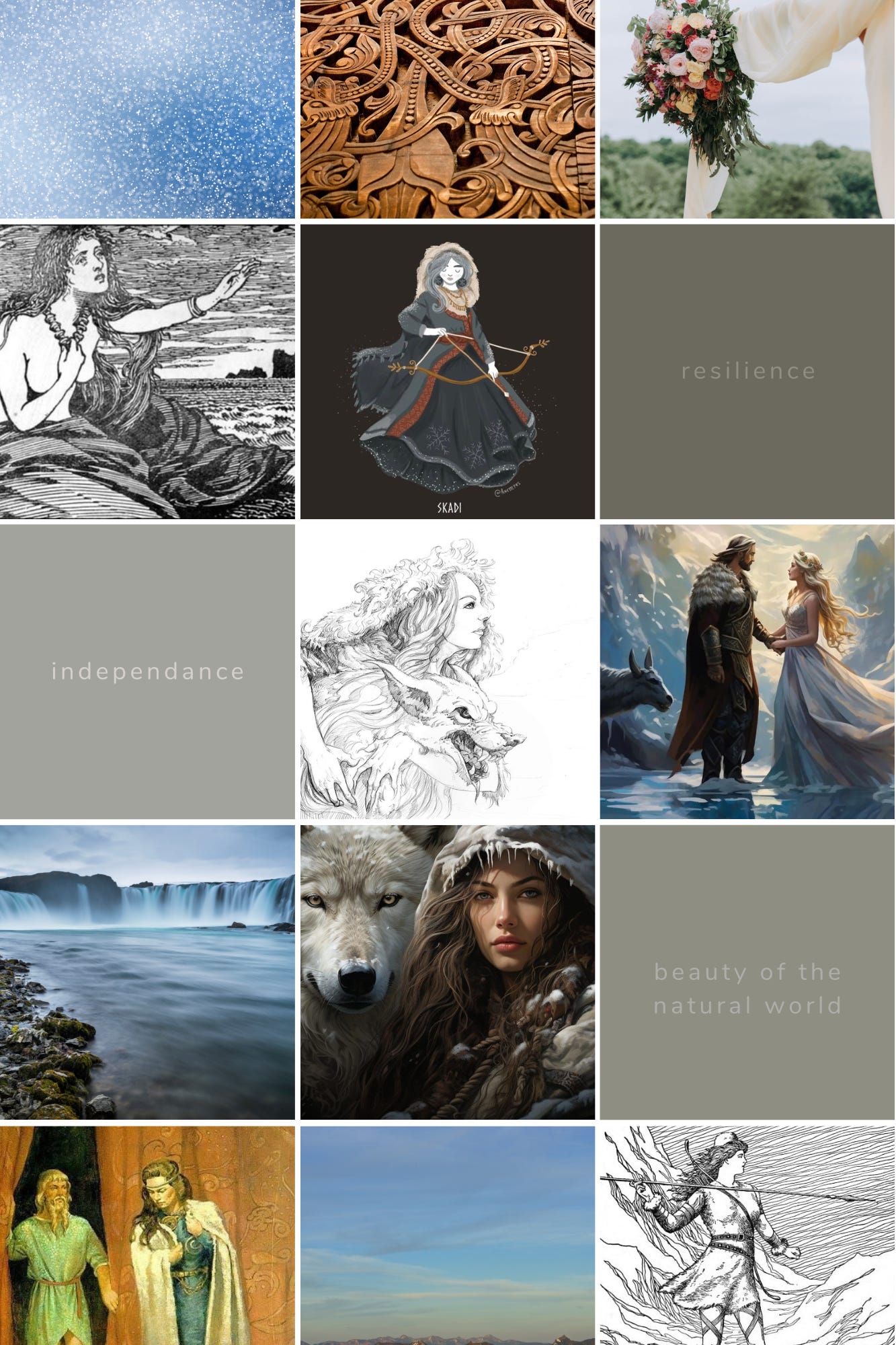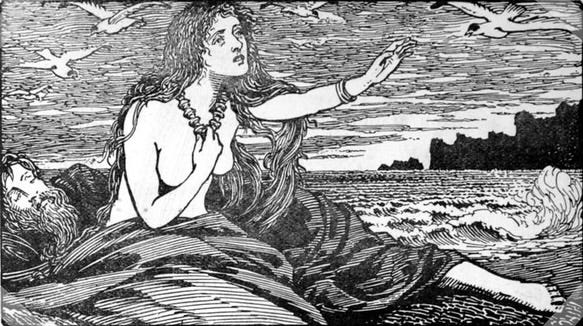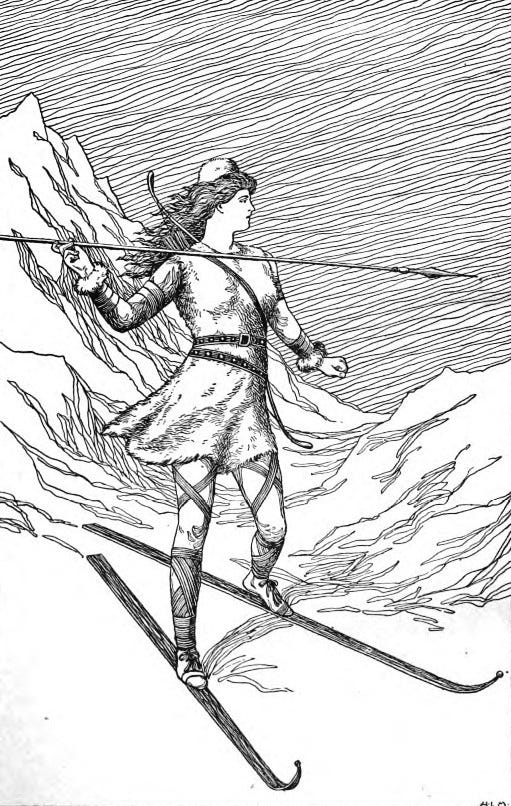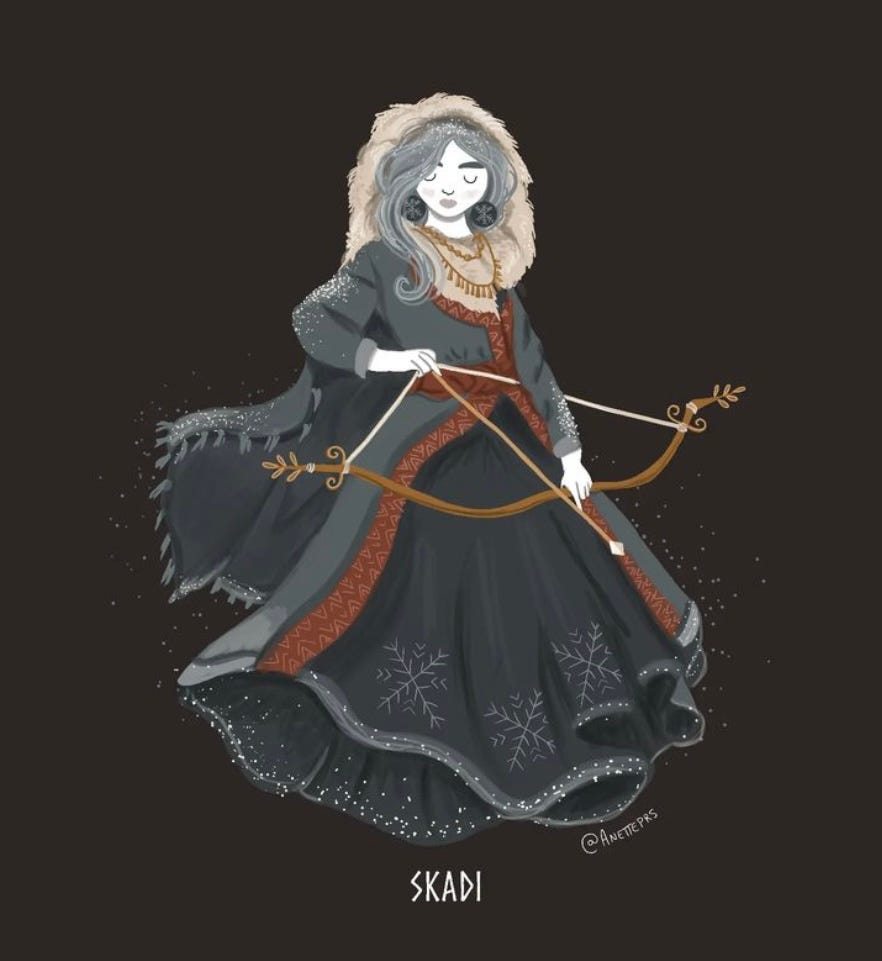Since beginning my journey into finding my own divine spirituality, I've witnessed a recurring theme among women—finding goddesses that resonate with their journeys, and souls, or simply captivate them. (Diving into this phenomenon could potentially be its own post, but for now, let’s simplify it down to the main religions of today severely lacking in women icons/messiahs/prophets/etc. for us to connect to.) Personally, I was initially drawn to figures like Mary Magdalene, whose story I find compelling but also familiar from my Christian upbringing. And there are goddesses like Persephone, whose mythology fascinates me, but ultimately doesn’t represent me. I started to feel as though I was failing in some way because I hadn’t found that symbol for myself.
Then, seemingly out of the blue, I encountered Skadi.
Skadi, an ice goddess in Norse mythology, emerged as a figure of strength and independence in the tales of the ancient Norse pantheon. Her story is rooted in a rich tapestry of mythology, where she is depicted as the daughter of the Jotun Thiazi, a giant who met his end in a fatal altercation with the Æsir. (In Norse mythology, the Æsir are a group of deities who reside in Asgard, one of the Nine Worlds and the realm of the gods. The Æsir are one of the two main groups of deities in Norse mythology, the other being the Vanir. The Æsir are known for their association with war, rulership, and wisdom. Many of the most prominent Norse gods belong to the Æsir, including Odin, Thor, and Tyr, the god of war and justice.)
In her first appearance in surviving Norse myth, Skadi shines as a beacon of resilience. Her story is one of determination, unwavering strength, and the refusal to be confined by the expectations of others. Despite her father’s death, she does not succumb to despair. Instead, she harnesses her grief and anger into a driving force, propelling her forward with unwavering resolve as she dons her armor and travels to the realm of the Æsir. She imposes two reparations on the Gods in order to establish peace between their realm and the giants: to make her laugh despite her somber mood (grief will certainly make for a somber mood)) and to provide her with a husband. The Gods agreed to her demands, but to achieve the first, the Æsir turned to Loki, known for his cunning and wit, to entertain Skadi. Loki engaged in various antics and eventually succeeded in making the goddess laugh.
As for the second condition, Skadi was allowed to choose her husband by looking only at the feet of the gods, as their true forms were concealed from her. Skadi expected to choose the handsome Baldr, but she mistook Njord's feet for Baldr's due to their beauty and cleanliness. When the gods revealed Njord, the sea God, as her chosen husband, Skadi accepted the marriage as part of the agreed-upon terms, despite her initial disappointment.
The mismatch between Skadi's preference for the mountains and Njord's affinity for the sea led to challenges in their marriage, ultimately resulting in an amicable separation. This mythological story illustrates the complexities of divine arrangements and the interplay between fate and personal desires in Norse mythology.
But this is also one of the most striking examples of Skadi's resilience and independent spirit, her refusal to compromise on her desires. When she is married off to the sea god, Skadi finds herself torn between two worlds. Rather than resigning herself to a life that does not align with her true nature, she stands her ground. Skadi insists on spending time in her beloved mountains, even if it means facing discomfort and challenges. Her unwavering commitment to her own happiness and fulfillment is a testament to her resilience.
Skadi's resilience extends beyond her personal desires; it is a reflection of her inner strength and independence. She is not content to simply accept her fate but instead takes control of her own destiny, forging a path that aligns with her values and passions.
In Skadi, I found a powerful reminder that resilience is not just about bouncing back from adversity but also about standing firm in the face of challenges. It is about refusing to be defined by circumstances and instead carving out our own paths, guided by our inner strength and determination. Her example inspires me to embrace individuality, and to live authentically, free from the constraints of external pressures.
Skadi's story is not only one of resilience and independence but also one that celebrates the beauty and majesty of the natural world. Her deep connection to nature, particularly the mountains and snow, serves as a powerful reminder of the wonders that surround us.
In Norse mythology, Skadi is often associated with the winter season, embodying its fierce yet captivating essence. She is known as a goddess of the mountains, a huntress who finds solace and joy in the rugged terrain and the pristine snow that blankets it.
One of the most iconic aspects of Skadi's connection to the natural world is her love for skiing. In Norse mythology, Skadi is depicted as a skilled skier, gliding effortlessly across the snow-covered slopes of her mountainous domain. This imagery not only showcases her physical prowess but also highlights her deep affinity for the winter landscape.
Skadi's love for the natural world extends beyond mere admiration; it is a profound bond that shapes her identity and brings her immense joy. For her, the mountains are not just a backdrop but a source of inspiration and strength. They represent the untamed beauty of nature, a reminder of the raw power and resilience that permeate the world around us.
In my modern life, it can be easy to lose sight of the beauty that surrounds me. I become caught up in the hustle and bustle of daily life, often forgetting to pause and appreciate the wonders of nature. (My rock tumbling journey was born from the joy I found in collecting treasures while on hikes with the boys.) Skadi's story serves as a powerful reminder to reconnect with the natural world, to find joy in its majesty, and to allow its beauty to nourish my soul.
(Side note: It does not hurt my connection to Skadi that I have a deep obsession with the snow and winter. If you feel the same, keep on eye on my Notes for the Winter Writing Prompts I am doing so you can join as well!)
Skadi's significance extends far beyond her marital endeavors though, being far more than the peripheral goddess she seems to be in some retellings. Revered in Norway and Sweden, her name echoes in the landscape, with Scandinavia itself being seen as "Skadi's Land." Her significance predates the Æsir in the region, and she continued to be venerated even after the spread of Christianity, making her one of the last Norse deities to be actively worshipped. This is evidenced by the continued use of her name in place names and possibly in folk traditions that survived into later centuries.
Additionally, Skadi's association with winter and death may have taken on new meanings in the Christian context, where winter and death are often associated with themes of rebirth and resurrection. This could have allowed for a reinterpretation of Skadi's role in the natural world, aligning it with Christian narratives. The name "Skadi" even translates to "Shade," a term that may allude to the dim winter sun or shades of the dead, hinting at her associations with the winter season and death. She is also known as a death goddess with dominion over hunting, credited with teaching men the art of hunting with bows and arrows. Legends speak of annual sacrifices made to her, which persisted in remote regions until possibly as late as the seventeenth century. But it is also worth noting, despite her association with death, Skadi is also a goddess of assistance, known as the Snowshoe Goddess, who aids winter travelers lost in storms or snow. Her multifaceted nature encompasses both the aspects of life and death, reflecting the complexities of the natural world itself.
Overall, while the specifics of Skadi's influence in the transition from paganism to Christianity are not fully documented, her presence in Norse mythology and her significance as a goddess of nature and independence likely had some impact on the evolving religious landscape of Scandinavia during this period.
With this background in mind, Skadi's story, though rooted in Norse mythology, continues to resonate today, offering timeless lessons and inspiration that transcend the ages. Her story weaves a tapestry of timeliness wisdom, resilience, independence, and finding solace in the beauty of the natural world, which holds valuable insights for navigating the complexities of my life.
Skadi's resilience in the face of adversity serves as a beacon of hope, reminding me that we possess the inner strength to weather life's storms and emerge stronger on the other side. Her unwavering commitment to her own desires speaks to the importance of staying true to myself, even when the world tries to pull me in (a million) different directions. And finally, Skadi's deep connection to nature offers a profound lesson in the value of preserving and cherishing the world around us. Her love for the mountains and snow serves as a reminder of the beauty and majesty of the natural world, urging us to tread lightly and protect the environment for future generations.
As you reflect on Skadi's story, let us embrace her spirit—the spirit of resilience, independence, and reverence for the natural world. Let us draw inspiration from her example, finding strength in adversity, asserting our independence, and fostering a deep connection with the world around us.
I am proud, and excited, to share that Skadi might just be the goddess I have been waiting for.




